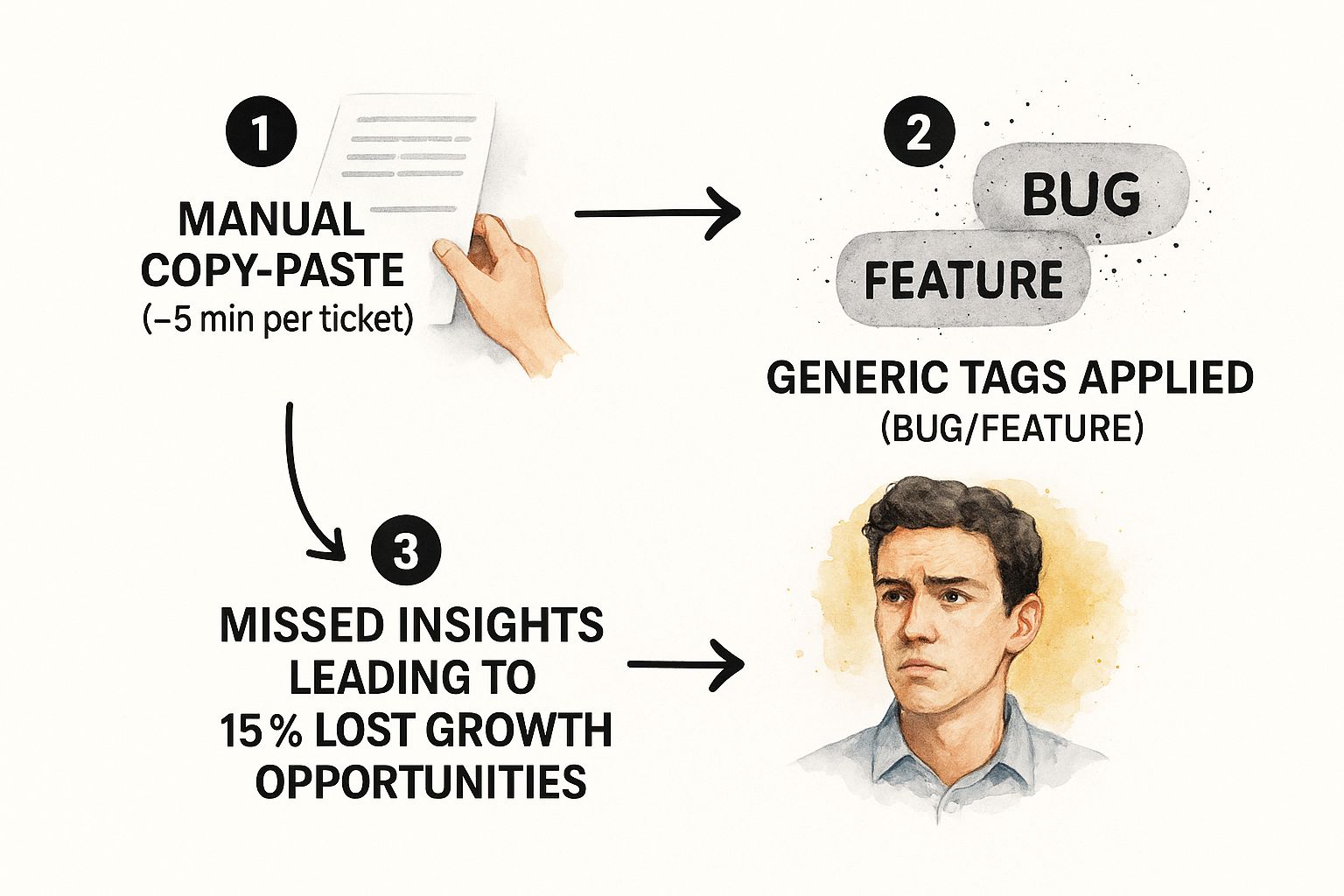Your Gut Feeling is a Terrible Way to Run a Business
Stop guessing. This guide shows founders how to find actionable insights from data you already have to build products people actually want and pay for.
Posted by
Related reading
Customer Advisory Board: The Founder's Playbook for Avoiding Catastrophic Mistakes
A practical guide to building a customer advisory board that provides honest insights, validates your strategy, and prevents costly product mistakes.
Why Reputation Management Tools Matter More in 2025 Than Ever
Learn how reputation management tools help businesses track reviews, analyze feedback, and protect brand image. A modern guide with AI-driven insights using Backsy.
10 Product Strategies That Actually Work (With Real Examples)
Stop guessing. We broke down 10 battle-tested examples of product strategies from companies like Apple, Netflix, and Slack. See what actually works.
Let’s be honest. You think you know what your customers want. You have “gut feelings.” You and your co-founder argue about which feature to build next based on a conversation you had with one user three months ago.
This is why most startups die.
You're sitting on a goldmine of raw, unstructured customer feedback—support tickets, chat logs, App Store reviews, angry emails—and you're treating it like a digital complaint box. A chore for your lowest-paid employee to "manage." Ignore your customers, and you’ll be lucky to survive the quarter.
Your Customer Feedback Is a Goldmine You Use as a Doorstop
That stream of "noise" from your loudest users? It’s a direct line into your user’s brain. It's where you find the friction points, the churn signals, and the billion-dollar ideas you’re currently blind to.
And if you think "listening to customers" means caving to every random feature request, you’ve already lost. This isn't about appeasement. It's an intelligence-gathering operation.

The Signal Hidden in the Noise
Think of feedback like enemy troop movements. A single report is an anecdote. Ten reports of movement in the same sector? That’s a pattern. A hundred reports? That’s an invasion force about to wipe you off the map, but you can't see it because your data is scattered across five different systems.
You get fixated on the literal request instead of the root cause. Here’s how you’re probably messing this up.
Feedback Source vs. The Goddamn Point
| What you see (The Symptom) | What it means (The Disease) |
|---|---|
| Spike in "password reset" tickets | Your onboarding flow is so broken it's killing activation. |
| A 1-star App Store review | A public billboard advertising your product's biggest weakness. |
| Sales notes about a competitor | A clear signal of a market expectation you're failing to meet. |
| Vague feedback like "it's confusing" | A specific UX flaw is causing rage-quits and lost revenue. |
See the difference? It’s not about appeasing users. It's about finding themes that cost you money. This requires more than a keyword search. You need methods like Natural Language Processing Customer Feedback Analysis to understand what they mean, not just what they say.
Bill Gates said, "Your most unhappy customers are your greatest source of learning." He wasn't telling you to build whatever they scream for. He was telling you to find the root cause of their anger. That's the gold. When you dig into the why, you uncover the critical https://backsy.ai/blog/customer-feedback-insights that lead to a better product.
Takeaway: Raw customer feedback isn't noise; it's the cheapest, most brutally honest consulting you'll ever get.
Ditch the Spreadsheet Your Intern Built
Let’s talk about your "process." It involves an intern, a sprawling Google Sheet, and a vague sense of dread. Someone copy-pastes comments, slaps on generic tags like ‘bug’ or ‘feature request,’ and calls it a day.
That isn't data analysis. It's data entry. It’s theater to make you feel productive while telling you absolutely nothing. That spreadsheet will never tell you that 15% of trial users abandon checkout because your UI for adding a team member is a nightmare.
This manual, surface-level tagging is precisely why your data isn't actionable. It’s slow, biased, and blind to the themes connecting dozens of seemingly random complaints into one, clear story of what’s broken.
This diagram is the soul-crushing, insight-killing process you're probably stuck in.

Every step is a place where context is lost and valuable feedback is watered down until it’s useless.
Why Your Spreadsheet Is Actively Costing You Money
Your spreadsheet is a graveyard where good insights go to die. It’s organized enough to look official but too shallow to provide any real direction.
This broken system is why you aren't a data-driven company. And that’s not just a buzzword. Data-driven organizations are 23 times more likely to acquire customers and 19 times more likely to be profitable, according to McKinsey. They do it by embedding real data into decisions, not by admiring a spreadsheet.
To get there, compare business intelligence tools that act as a command center, not a to-do list. The goal is building business performance metrics dashboards that force smart decisions.
Takeaway: Stop celebrating the activity of data entry and start demanding the outcome of actionable intelligence.
The Machine That Turns Complaints Into Cash
Alright, you’ve admitted your spreadsheet is a dumpster fire. Good. Now, how do you actually pull actionable insights from feedback without hiring a team of analysts you can't afford?
You use a machine.
Not Skynet. Think of it as a force multiplier. It frees up your people to solve problems instead of tallying them. You connect your data sources—Intercom, Zendesk, Slack, G2 reviews, App Store rants—and let it ingest the chaos.

From Word Soup to a Prioritized Hit List
Here’s what your spreadsheet can't do. The machine uses natural language processing to understand sentiment, intent, and context. It knows the difference between "This bug is annoying" and "This bug just corrupted my entire account, and I'm canceling." That nuance is everything.
It clusters thousands of messy complaints into quantified themes.
For example, it sees these three separate comments:
- "Can't figure out how to add a user."
- "Where is the invite team member button?"
- "My colleague never got the invite email."
The system knows this isn't three issues. It's one giant, flashing red light labeled 'Broken Team Onboarding Flow.' Instead of a spreadsheet with 10,000 rows, you get a dashboard that screams, "Hey, 28% of your churn risk is tied to this one broken workflow. Fix it."
This is how you turn a firehose of raw text into a prioritized list of problems worth solving. The fundamentals of natural language processing for business are what make this possible. You’re no longer guessing; you’re operating on quantified reality.
Takeaway: Let a machine find the patterns in the noise so you can focus on building solutions.
Turning Vague Feedback Into a Crystal-Clear Roadmap
So the AI served up a dashboard. 15% of users hate your invoicing. Onboarding sentiment dipped 22%.
Great. Now what?
An "insight" is just trivia until it forces a decision. This is where most teams fail. They get the data, nod thoughtfully, then go back to building the shiny feature they wanted to build anyway. Don't be that team.
A quantified problem is the starting gun. Your job is to turn that number into a directive for your product team. This is how you stop arguing and start making data-backed bets.

From Problem to Priority
For every theme the AI surfaces, answer four questions. Brutally.
- Problem: What is the specific, quantified issue? ("Users are struggling with invoicing.")
- Root Cause: Why? Dig deeper. ("The UI for adding a line item is confusing, and there’s no way to save a recurring client.")
- Solution: What is the smallest possible fix? No over-engineering. ("Redesign the line item flow and add a 'save client' button.")
- Impact: What’s the business cost of not fixing this? ("This issue drives 15% of support tickets, 40% of 1-star reviews, and our top competitor has a killer invoicing feature.")
This framework draws a straight line from user frustration to business pain. Now you can walk into a meeting and say: "We are fixing the invoicing flow this quarter because the data proves it will cut support load by 15% and improve retention. Here's the evidence." You’re no longer asking permission based on an opinion; you're presenting a business case. Given the challenges of data transformation from these statistics, this clarity is non-negotiable.
Score Your Problems Like a VC
Rank each problem on a 1-5 scale:
- Volume: How many users are complaining?
- Sentiment: How angry are they? (Annoyed vs. canceling)
- Revenue Impact: Is this hurting your biggest customers?
Add up the scores. The issue with a 15/15 is your top priority. The one with a 4/15 goes to the back of the line. No more arguments. Just math.
Takeaway: An insight isn't a fact; it's a fact with a dollar sign attached that forces a decision.
Stop Predicting the Future and Start Building It
Everyone is obsessed with "predictive analytics," hoping a crystal ball will tell them what customers want next. Wrong. The goal isn't to predict the future—it's to have the right information to build it.
When you systematically analyze customer feedback, you stop playing defense. You spot the patterns that lead to churn and fix them before they become five-alarm fires. It’s an early-warning radar for your business.
From Reactive Firefighting to Proactive Strategy
Imagine a spike in support tickets mentioning a competitor's new feature. Without a system, you might not connect the dots for weeks. By then, your sales team is getting hammered and you’re already behind.
Now imagine a system that flags that trend on day one. You can huddle with your product team and decide a response that afternoon. You’re no longer reacting to the market; you’re anticipating its next move. You don't need a crystal ball. You just need to listen to the present, but at scale.
This is your competitive edge. You're operating on ground truth. Your product team knows what to prioritize. Your marketing team knows which pain points to hit in their ad copy because they're seeing the exact words customers use. You can read more in this great breakdown of data-driven decision-making on passivesecrets.com.
This mindset changes everything.
- Before: Reacting to a flood of 1-star reviews about a confusing feature.
- After: Detecting rising friction around that feature and shipping a fix before it boils over.
Takeaway: Use real-time customer data to build the future before your competitors see it coming.
Look, you’ve made it this far. You're either curious about pulling real actionable insights from your data or you’re convinced this is all fluff.
What comes next isn’t a link to a dry whitepaper. That’s for people who like talking in meetings more than getting results. The real test is looking at the unvarnished truth hiding in your own customer feedback.
Here's the hard truth: your opinion doesn't matter. Your team's opinion doesn't matter. The only thing that matters is what your customers are telling you, for free, every single day. If you're serious about this, stop pretending your color-coded Google Sheet is a strategy.
You can build a business on reality, or you can build it on assumptions. Your choice.
Stop theorizing about what customers want and use Backsy to see what they’re actually screaming at you.